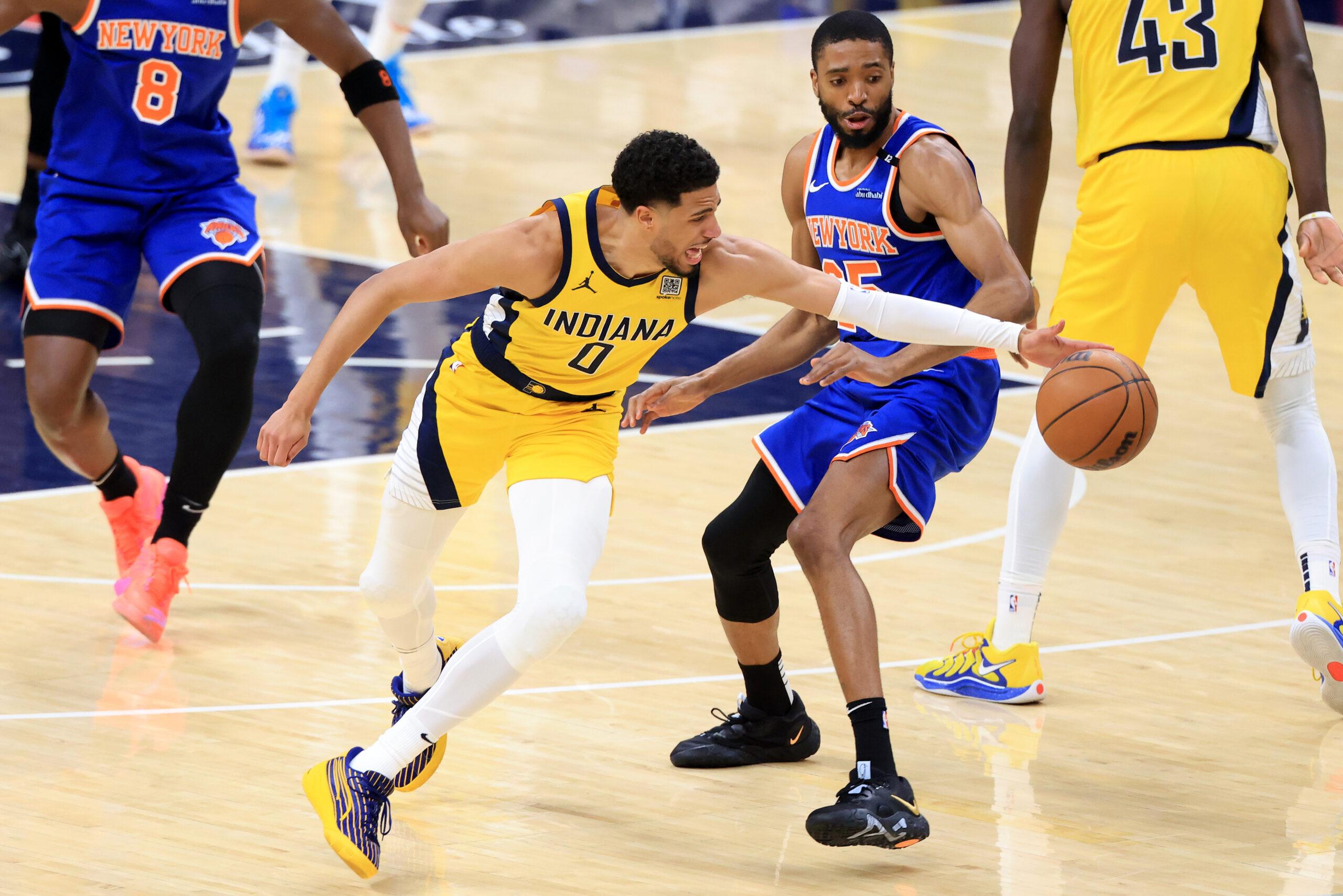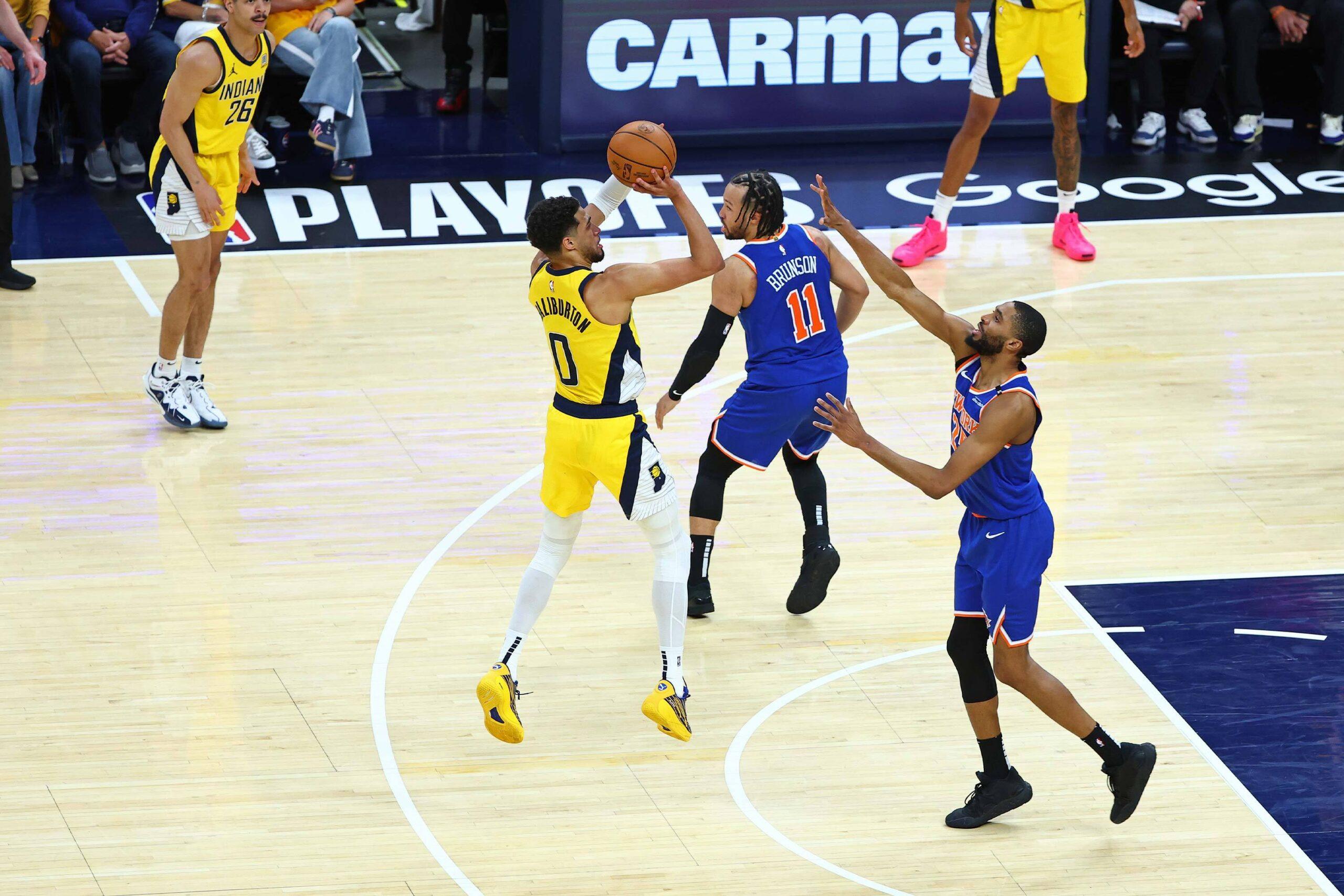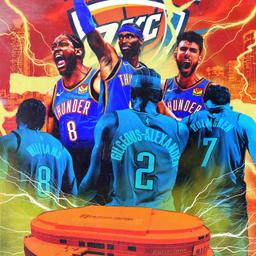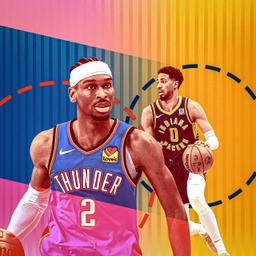The Oklahoma City Thunder and Indiana Pacers are, in so many ways, stylistic kindred spirits. They emphasize similar things, know their own identity, boast incredible depth, and refuse to deviate from the coaching staff’s game plan regardless of how poorly things are going in the first frame—a degree of stability that can’t happen without trust and a huge reason both teams have gotten this far.
Whether it’s turnovers, pace, pick-and-roll coverages, or each team’s shot diet, so many of the topics covered in this NBA Finals preview are interconnected. The series features genuine star power—Shai Gilgeous-Alexander, Tyrese Haliburton, Jalen Williams, and Pascal Siakam—leading A+ supporting pieces who understand and accept their purpose on both ends. Roles are maximized with indispensable performers on each side, whether it’s Alex Caruso and Andrew Nembhard knowing exactly where to be on defense before the offense can get there, or Aaron Nesmith and Lu Dort assuming impossible on-ball assignments every night before they knock down a few season-saving 3s.
The big difference between the two? Well, OKC is way better. The gap between the Thunder’s no. 1 regular-season net rating and the 13th-ranked Pacers’ was about the same between the latter and the Charlotte Hornets. Indiana enters the Finals with this postseason’s top true shooting percentage, though, at a number (61.7 percent) that eclipses what the league-best Cleveland Cavaliers produced during the regular season. Hope springs eternal. Here are a few subplots to keep an eye on throughout the series, as well as my prediction.
Watch for pace, pace, and more pace.
In myriad ways, speed will define these Finals. Can the Pacers turn every game into a track meet and catapult themselves from one baseline to the other off of made and missed shots? It’s a fascinating question against a stingy Thunder defense that does a great job of getting back in transition. According to Cleaning the Glass, OKC finished the regular season ranked second in opponent transition frequency and second in transition points added per 100 possessions. In the playoffs, they’ve done an even better job of limiting those opportunities and have allowed the second-fewest fast-break points.
Here’s where things get even more interesting: The only team that ranks ahead of OKC in most of those categories? The Pacers! This matters because no team, including zippy Indiana, has registered a quicker offensive pace than the Thunder. Sure, Indy thrives in chaos. But OKC was born in it. Molded by it. Pure velocity is its ally.
It’s not entirely because of the Thunder’s elite defense, either. Name the situation—after made field goals, made free throws, dead balls, missed midrange jumpers, etc.—and they’re flying out of it. The Thunder might be even more proficient than the Pacers at running their opponent into the ground. They average a playoff-best 142 points per 100 transition plays and are young, deep, and athletic enough to sustain that tempo until the other team wilts.
Even though Indiana gets the ball past half court with 20 or more seconds on the shot clock on nearly 73.5 percent of its possessions—a substantial playoff high, per Sportradar—that up-and-down pace isn’t the only type of hurry OKC needs to worry about. The Pacers averaged the fewest seconds and dribbles per touch during the regular season. In the playoffs, only the Golden State Warriors were more eager to share the ball. Even in the half court, Indy’s actions are a blur.
There are so many ripple effects when two teams are able and willing to run themselves ragged. How deep will each bench go? Will Rick Carlisle and Mark Daigneault fiddle with 10-man rotations in the NBA freaking Finals? And if it’s a long series, how exhausted will so many important players on both sides be as they near the end of the longest season they’ve ever played? Do we get an Isaiah Joe or Jarace Walker game—assuming Walker’s healthy enough to play after injuring his ankle in Game 6 of the Eastern Conference finals—or [crosses fingers] will there be another unfortunate injury caused by all this haste that will tilt the outcome?
Will applying full-court pressure on Jalen Williams, Gilgeous-Alexander, and the rest of OKC’s ball handlers backfire against Indiana, or disrupt and wear down an offense that’s relatively ineffective in the muck? The Thunder are averaging 97.3 points per 100 half-court plays in the playoffs, which is very good but ranks fifth and is down from the 104.6 they generated during the regular season. (The Pacers rank first, at 105.7.)
Which team will do a better job of taking advantage of/limiting inevitable cross matches? OKC’s adaptability in real time is part of the reason it is so good in transition. That’s not ideal for Siakam, who dined on easy kick-ahead buckets in the conference finals. (In the regular season—OKC was 2-0 against Indiana—the Thunder were fine putting Williams on Myles Turner and Isaiah Hartenstein on Siakam; Chet Holmgren didn’t play in either game.) On the other end, Indy would rather get back than go to the offensive glass. But, still, how often can the Thunder catch poorer defenders like Haliburton, T.J. McConnell, or Obi Toppin with a mismatch in the open floor?
Will Indy’s pace force the Thunder to downsize and play more lineups with Cason Wallace, Caruso, or Aaron Wiggins instead of two bigs? Does Daigneault change his starting lineup or begin second halves with Hartenstein on the bench (as he’s already done in these playoffs)?
Regardless of how the answers to these questions shake out, the aesthetic highs in this Finals should be breathtaking. One way or another, many, many, many points will be scored.

Turnovers will be everything.
Both of these teams are diehard believers in the possession game. Both take care of the ball and do a tremendous job of capitalizing off the turnovers they force. This season, Oklahoma City was first in turnover rate—including a tight 6.4 percent in two games against the Pacers, its lowest mark against any opponent—while Indiana finished third.
On the playoff leaderboard, Gilgeous-Alexander, Holmgren, and J-Dub all rank in the top 20 for turnover percentage. The Pacers, meanwhile, rank first in assist-to-turnover ratio. Siakam hardly ever coughs it up, and Haliburton might be the most trustworthy point guard in the league.
On defense, the Thunder are obsessed with (and exceptional at) ending their opponent’s set with a fast break the other way. They have 30 more steals than any other team in the playoffs, and the runner-up, New York, played two more games. It’s a corrosive, corruptive, psyche-dismantling approach. Thunder defenders live in gaps, with opportunistic hawks like Williams, Wallace, and Caruso bobbing between their man, the paint, and the ball. As a collective, they don’t allow much airspace (Dort in particular) and do a tremendous job of applying pressure on the outside as elite rim protectors anchor the lane. Hands are everywhere. Arms are wide. Blow-bys are accounted for and snuffed out. Double-teams and help-the-helper rotations are perfectly timed, executed as if all five teammates share the same brain.
OKC led the league in points off turnovers and fewest points allowed off turnovers. It also committed at least one fewer turnover than its opponent in a league-high 75 games this season. The only team in NBA history that sits above the Thunder here is the 1988 Denver Nuggets, at 76 games. (The Pacers ranked third this season, at 66 games.) Having an MVP who efficiently averaged well over 32 points a night is very cool and important, but the Thunder are a historically dominant team because they scrap and claw and maul their way to more bites at the apple than their opponent.

It sounds reductive to claim that whichever team makes fewer mistakes (and is best able to exploit the other team’s errors) will raise its franchise’s first championship banner, but when it’s all said and done, that may be what happens. And, because OKC has a significant defensive edge and makes every opponent forget how to dribble and/or pass for quarters at a time, it’s easy to see why Indy’s margin for error in this particular matchup barely fits inside a thimble.
Normally, the Pacers love to cram defenses in a nutribullet. They sprint the floor, identify a mismatch, force a rotation, then start popping the ball around until someone gets an open shot. It’s relentless, selfless, kaleidoscopic basketball deployed with a random flurry of drives, cuts, screens, and dribble handoffs. Can they sustain it with the degree of manipulation that got them here against one of the most suffocating, versatile, and aggressive defenses the league has ever seen? Plays like this, where the Thunder can switch everything off-ball, help if need be, and get Indy late in the shot clock, are exactly what the Pacers do not want to see:
Indy moves the ball a ton, but it does so with restraint, leveraging the confusion caused by all its screens and man movement to its advantage via low-risk passes that rarely appear premeditated. According to Sportradar, the Pacers average at least four passes in 22.5 percent of their possessions (a playoff high). Their turnover rate on these plays is 8.8 percent. For most teams in this situation, the vault is cracked open. The Pacers make you breach a second padlock.
Can they deploy the style that got them here without unnecessarily getting their pockets picked half a dozen times? Or, can they shift even more responsibility onto Haliburton’s lap, apply pressure, and generate the same quality looks? If the answer to both questions is no, it’s almost impossible to picture Indiana keeping these Finals competitive, let alone pulling off the massive upset and winning it all.
Are long 2s back?
Everyone loves to talk about 3-point variance, and it’s irrefutably important for both teams to knock down quality looks when they appear. But 2-point jump shot variance is a thing, too! The Pacers are in the Finals because they feast from the midrange: 12.1 percent of their shots are 2-pointers outside the paint—an area of the floor most defenses are happy to concede—and they’re making 47.4 percent of them.
There are 21 players in the playoffs who’ve taken at least 20 midrange shots; four of the five most accurate play for the Pacers: McConnell is at 75 percent, Haliburton is at 53.3, Turner is at 52.0, and Nembhard is at 49.0. Sixth on that list is SGA, at 47.9 percent on far more attempts than anybody else; J-Dub’s ability to snake a pick-and-roll and consistently pull up from a spot at which he’s comfortable is an unavoidable gut punch that makes the Thunder feel invincible every time it goes in (which is often).

This isn’t a plea for the Pacers to seek out long 2s. Those attempts are yielding 0.94 points per shot right now, while 3s have earned them 1.23 (both marks lead the playoffs), but if Indiana is going to pierce OKC’s armor—an elite defense that can pack the paint and make 3-point shooters flinch—it’ll need to convert the relatively inefficient looks that helped get it this far, whether open or contested.
That means Turner needs to hit those bank shots out of a short roll when the Thunder put two on the ball. It means Siakam has to make the baseline fallaways and mid-post turnarounds when he’s guarded by a smaller defender. It means Haliburton and Nembhard have to cash out after they create space with a stepback. By and large, the Pacers aren’t uncomfortable with these shots. They’ve made 23 more of them than any other playoff team after finishing fourth in total attempts and sixth in accuracy during the regular season. If they want to keep games within striking distance, they can’t afford to miss way more of them than they make over the next three weeks.
Related …
Will corner 3s swing the series?
The Thunder allowed more corner 3s than any other defense during the regular season. This is a seemingly painful trade-off that spills down from their fundamental decision to regularly help off the perimeter and pack the paint. They swarm, blitz, double-team, show bodies, and then sprint out to contest shots with long, fast, smart defenders.
In theory, this is a risk. In theory, an elite 3-point shooting team should be able to punish them for it. Indiana has as good a chance as anyone to be that team. The Pacers have been unconscious from the corner throughout these playoffs, nailing 46.9 percent of their shots while generating them at a decent clip.
If this is something OKC is genuinely concerned about, the Thunder have enough flexibility to scrap their base scheme and still be a brick wall. They can switch across the board, stay home, and still bother drives at the basket without much help. But they won’t deprioritize the paint or tamp down their aggression along the perimeter until Indiana makes them.
The Pacers shot 53.8 percent from the corners against OKC during the regular season and lost both games. When I say their margin for error is microscopic, this is what I mean. When the Thunder put two on the ball, Indy hit the roll man, forced a rotation, and then kicked it out for an open look. If there was any miscommunication or hesitation on the Thunder’s part—in the second play seen below, J-Dub doesn’t pressure the ball and Joe doesn’t immediately scram switch with Hartenstein out of the mismatch—Indiana capitalized.
That level of precision must carry over for the entire series, both in the half court and when they find open shooters in transition. The open floor must be their best friend. The Pacers have now finished 11 playoff games with more assisted corner 3s than the other team. They’ve won all of them.
How will the Thunder guard Haliburton’s pick-and-rolls?
If Haliburton can’t be the Generation Z iteration of Steve Nash who just buzz-sawed through three straight teams with elite vision, rhythmic control, and three-level shot-making, Indiana is screwed. A lot of that will come down to his decisions out of the pick-and-roll. When these two teams squared off during the regular season, Oklahoma City mixed in different coverages while primarily switching the screener’s defender—often Hartenstein—onto Haliburton:
Ceding a mismatch is not OKC’s style, but the Thunder clearly didn’t want to put themselves in rotation and let Haliburton carve them up with his passing. It’ll be interesting to see how often that strategy occurs in the Finals. Dort, Caruso, Wallace, and Williams have had immense success in these playoffs at the point of attack; if Hartenstein’s man sets a ball screen and they don’t want to change their matchup, they won’t. (OKC can also just move Hartenstein around—maybe put him on Nesmith instead of Turner?—or simply utilize smaller lineups.)
There’s no obvious target for Haliburton to go after (assuming Joe’s minutes align with when Haliburton rests) in this series. Jalen Brunson, Darius Garland, and Damian Lillard aren’t walking through that door. But one wrinkle to keep an eye on is Holmgren, who, again, did not face Indiana in the regular season. It’ll be interesting to see who Chet guards, how often Haliburton uses his man to set a screen, and how, tactically, it’s defended. Will the Thunder switch, blitz, drop back, or stay up to touch? Will they mix in some zone, as they did a little bit back in December?
Generally, what do the Thunder even want to accomplish? Would they prefer Haliburton be forced to repeatedly attack one-on-one? Or would they rather see Nembhard, Siakam, or McConnell grab the steering wheel as Hali is removed from the equation as often as possible?
The Pacers have a say in all this, of course. They can set screens closer to half court, run double drags, use Haliburton as the back screener in a stack pick-and-roll, and show why they’re one of the most creative offenses in the league. Creating good shots out of these actions, with their best player at the helm, is important in a series that feels lopsided heading in. For now, though, it doesn’t lack intrigue.
My prediction is …
The Pacers glide into the Finals on a magic carpet ride. They’re easy to root for and embrace a style of play that’s fulfilling, inexhaustible, and pleasing to the eye. Everything about their run is remarkable, and, if you don’t think Haliburton is a top-10 player, it’s virtually unprecedented in the modern era. Unfortunately, they’re about to run into a healthy, stacked, superior version of what they see in the mirror.
According to recent NBA history, every champion who was expected to wear the crown for the foreseeable future—the Lakers, Bucks, Nuggets, and Celtics—were one-and-done instead. But the Thunder may have the ingredients—youth, depth, foresight, talent, and luck—to buck that trend. Every so often a team comes along that’s special enough to bend every other aspirational franchise’s path to the top into a cul-de-sac. Oklahoma City appears to be that team.
Thunder in five.




